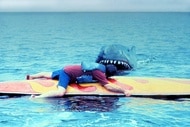What to Do if You See (or Experience) a Shark Attack
Hopefully, this is information you'll never need!
There was nothing anyone in the fictional town of Amity Island could have done to prevent the first deadly shark attack. A young woman, enjoying an evening on the beach with friends, slips into the water and never emerges. Her body, shredded by rows of predatory teeth, washes up on the beach the following day, spurring an investigation from the new police chief, Martin Brody (Roy Schieder).
In the opening act of Steven Spielberg’s Jaws (streaming now on Peacock), Chief Brody closes the beaches, but the mayor has other ideas, weighing the potential of additional casualties against the wave of tourist money about to flood in. Later, a young boy is killed in full view of onlooking beach goers, settling the beach-closing question once and for all. There was nothing anyone could have done to prevent the first attack, but the city’s handling of the ongoing crisis could have been better.
Had they listened to Chief Brody from the jump, Amity Island might have lost some tourist dollars, but it would have saved lives. In the real world, shark attacks are exceedingly rare, but they do tend to spike in the summers, when people are more frequently in the water.
The odds of being bitten by a shark across a lifetime, let alone on any particular outing to the beach, are incredibly slim. You’re more likely to die in a bicycling accident or in a lightning strike. Bears, dogs, and the flu each kill more people every year than sharks do. In fact, you’re at higher risk of injury or death driving to the ocean than you are swimming in it. Still, the possibility exists every time you step into the water. If you find yourself face-to-jaws with a shark in the water, or if you see someone else attacked at the beach, here’s what you should do.
For More on Sharks:
The 10 Weirdest (Coolest) Sharks of All Time
The 6 Coolest Things You (Probably) Didn't Know About Sharks
Cocaine Sharks! Scientists Find Sharks Contaminated with Cocaine off the Coast of Brazil
What to do if you (or someone else) are bitten by a shark
The first thing to know is that if you’ve spent any time in the ocean, you’ve probably been within striking distance of a potentially killer shark. Most of the time they leave us alone. Recent research along the California coast found that beach goers are in close proximity with sharks more than 95% of the time they are in the water, with very few attacks.
The vast majority of the world’s 500+ shark species leave people alone entirely. Only a dozen or so species are known to attack humans, and most of the time even that is a case of curiosity or mistaken identity. In 2023, there were 69 unprovoked shark attacks recorded worldwide, but there were hundreds of millions of people visiting world beaches. The water itself is much more dangerous, with nearly a quarter of a million drowning deaths reported globally every year.
If you see a shark in the water, remember that it is a wild animal, and you are in its environment. You should treat it the same as you would when encountering a bear in the woods. Stay as calm as possible, the odds are in your favor and the shark will very likely go about its business, like so many unseen sharks before it. If the shark (or any other aquatic animal) is behaving in a way that makes you uncomfortable, then calmly leave the area and return to shore.
You can minimize the odds of an attack by swimming in groups, as sharks are more likely to attack an isolated individual. Stay out of the water if you have an open wound or are menstruating; a shark's ability to sniff out blood in the water is not a myth. They can smell blood in the water from as far as a quarter mile away, and they can sniff out a signal as diluted as one part per million from 100 yards away. Avoid swimming in low visibility or wearing shiny jewelry. A shark’s vision relies largely on contrast, shiny jewelry can be confused for fish scales and low light ups the odds of confusion. Likewise, avoid contrasting colors, including bathing suits and uneven tans, for the same reasons.
If you are bitten, fight back. Go for sensitive spots on the face and snout. Jab and punch at eyes, gill slits, and the sensitive snout itself. The idea is to make the shark think twice and opt for an easier meal elsewhere. If you have anything to hand, like a surfboard or diving gear, use that to create a barrier between you and the shark.
Once you (or the victim, in the case of a witnessed attack) are back on shore, ordinary first aid rules take effect. Apply pressure to staunch any bleeding; keep the person calm; provide blankets or other warmth if necessary, as the victim may be in shock; and contact first responders. An emergency first aid kit is a useful addition to any beach bag, just make sure you also have water and sunscreen, you’re way more likely to use them.
Or you could keep your kit safely locked away and just watch Jaws instead. Stream it now on Peacock!











































